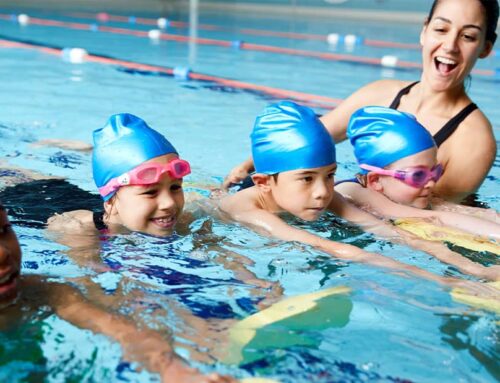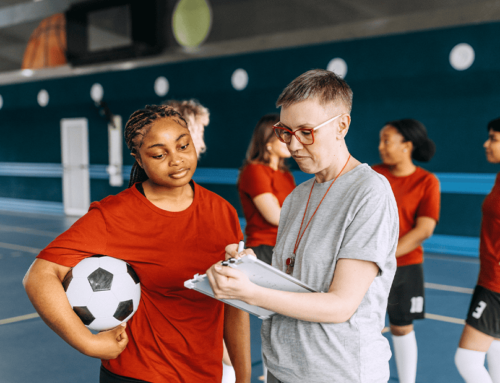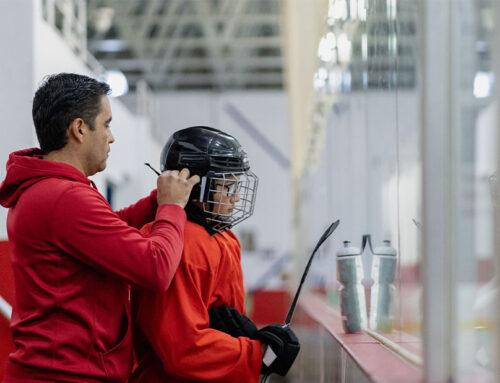How to Increase Skating Speed for Hockey, Part 1
There isn’t a hockey player, coach or scout who doesn’t value skating speed. To be successful on the ice, you must be able to outskate your opponent to break wide on a defender, crash the net or backcheck to break up a potential goal.
To improve your skating speed, you must break down the mechanics of your stride into three phases: glide, push and recovery. Improving each phase will increase your stride length and—more important—your stride rate. In fact, studies show that increasing stride rate should be the primary focus for hockey players who want to increase speed.
Glide Phase
The glide phase occurs when one skate is directly under your hips and your opposite leg is in a stride. This allows for loading of the hip, knee and ankle joints so that maximum force can be generated against the ice during the push phase. Holding this position requires a great deal of core and lower-body strength, which can be improved with Single-Leg Squats.
Single-Leg Squats
- Balance on right leg
- Keeping weight on heel, initiate movement by driving hips back
- Squat until thigh is near parallel to ground
- Explode out of squat position; repeat for specified reps
- Perform on left leg
Sets/Reps: 3×12 each leg
Push Phase
The push phase is when you perform the stride and push against the ice to propel forward. This is where your power comes from, although it generally constitutes only 10 to 15 percent of the overall stride time. This means that you generate great force in an extremely short amount of time. Typically, a hockey player’s glutes and quads are his strongest and most powerful muscles, meaning they are also the main muscles that propel him forward. Train these muscles for power and speed with Step-Ups.
Step-Ups
- Holding dumbbells at sides, assume athletic stance six inches from knee-high box or bench
- Place right foot flat on box or bench
- Contract right quad and glute to explosively drive body upward
- Drive left knee up until thigh is parallel to ground
- Bend right knee and hip to lower left leg to ground and return to starting position
- Repeat for specified reps; perform set with opposite leg
Sets/Reps: 3×12 each leg
Recovery Phase
The final phase of the forward stride is the recovery of the extended leg after the stride is complete, when the leg swings to the front of the body to return to the glide phase. Players should focus on a low and straight recovery, with the skate in position under their hips so that the opposite leg can begin its push phase. During recovery, the groin and hip flexor muscles are engaged. Increasing groin and hip flexor strength will allow you to recover your leg and increase speed. Improve your recovery phase with the Keiser Hip Flexor and Keiser Leg Adductions.
Keiser Hip Flexion
If Keiser machine is unavailable, use resistance band
- Assume athletic stance balancing on one leg with strap around opposite knee and cable behind body
- Flex hip and knee to pull knee toward hip until thigh is parallel to ground; keep foot flexed and upper body upright
- Slowly extend hip and knee to lower to start position; repeat for specified reps
- Perform set with opposite leg
Sets/Reps: 3×12 each leg
Keiser Hip Adduction
If Keiser machine is unavailable, use resistance band
- Assume athletic stance balancing on one leg with strap around opposite ankle and cable to the side
- Swing leg directly across body in front of balancing leg; keep leg straight
- Slowly swing leg back across body to return to start position; repeat for specified reps
- Perform set with opposite leg
Sets/Reps: 3×12 each leg
Regularly performing these exercises will produce an increase in your skating speed. In the Part 2 of this series, we will look at more skating-specific speed exercises that can be done on ice or on a skating treadmill.
Photo: rantsports.com
Adam Redmond, CSCS, owns RedTech Innovations, a software development company that analyzes the stride of hockey players. He also trains athletes at Crash Conditioning, and he has worked for more than a decade with Steve Serdachny, the Edmonton Oilers’ skating and skills coach. Redmond played hockey for the University of Calgary Dinos, where he was an Academic All-Canadian.
RECOMMENDED FOR YOU
How to Increase Skating Speed for Hockey, Part 1
There isn’t a hockey player, coach or scout who doesn’t value skating speed. To be successful on the ice, you must be able to outskate your opponent to break wide on a defender, crash the net or backcheck to break up a potential goal.
To improve your skating speed, you must break down the mechanics of your stride into three phases: glide, push and recovery. Improving each phase will increase your stride length and—more important—your stride rate. In fact, studies show that increasing stride rate should be the primary focus for hockey players who want to increase speed.
Glide Phase
The glide phase occurs when one skate is directly under your hips and your opposite leg is in a stride. This allows for loading of the hip, knee and ankle joints so that maximum force can be generated against the ice during the push phase. Holding this position requires a great deal of core and lower-body strength, which can be improved with Single-Leg Squats.
Single-Leg Squats
- Balance on right leg
- Keeping weight on heel, initiate movement by driving hips back
- Squat until thigh is near parallel to ground
- Explode out of squat position; repeat for specified reps
- Perform on left leg
Sets/Reps: 3×12 each leg
Push Phase
The push phase is when you perform the stride and push against the ice to propel forward. This is where your power comes from, although it generally constitutes only 10 to 15 percent of the overall stride time. This means that you generate great force in an extremely short amount of time. Typically, a hockey player’s glutes and quads are his strongest and most powerful muscles, meaning they are also the main muscles that propel him forward. Train these muscles for power and speed with Step-Ups.
Step-Ups
- Holding dumbbells at sides, assume athletic stance six inches from knee-high box or bench
- Place right foot flat on box or bench
- Contract right quad and glute to explosively drive body upward
- Drive left knee up until thigh is parallel to ground
- Bend right knee and hip to lower left leg to ground and return to starting position
- Repeat for specified reps; perform set with opposite leg
Sets/Reps: 3×12 each leg
Recovery Phase
The final phase of the forward stride is the recovery of the extended leg after the stride is complete, when the leg swings to the front of the body to return to the glide phase. Players should focus on a low and straight recovery, with the skate in position under their hips so that the opposite leg can begin its push phase. During recovery, the groin and hip flexor muscles are engaged. Increasing groin and hip flexor strength will allow you to recover your leg and increase speed. Improve your recovery phase with the Keiser Hip Flexor and Keiser Leg Adductions.
Keiser Hip Flexion
If Keiser machine is unavailable, use resistance band
- Assume athletic stance balancing on one leg with strap around opposite knee and cable behind body
- Flex hip and knee to pull knee toward hip until thigh is parallel to ground; keep foot flexed and upper body upright
- Slowly extend hip and knee to lower to start position; repeat for specified reps
- Perform set with opposite leg
Sets/Reps: 3×12 each leg
Keiser Hip Adduction
If Keiser machine is unavailable, use resistance band
- Assume athletic stance balancing on one leg with strap around opposite ankle and cable to the side
- Swing leg directly across body in front of balancing leg; keep leg straight
- Slowly swing leg back across body to return to start position; repeat for specified reps
- Perform set with opposite leg
Sets/Reps: 3×12 each leg
Regularly performing these exercises will produce an increase in your skating speed. In the Part 2 of this series, we will look at more skating-specific speed exercises that can be done on ice or on a skating treadmill.
Photo: rantsports.com
Adam Redmond, CSCS, owns RedTech Innovations, a software development company that analyzes the stride of hockey players. He also trains athletes at Crash Conditioning, and he has worked for more than a decade with Steve Serdachny, the Edmonton Oilers’ skating and skills coach. Redmond played hockey for the University of Calgary Dinos, where he was an Academic All-Canadian.











